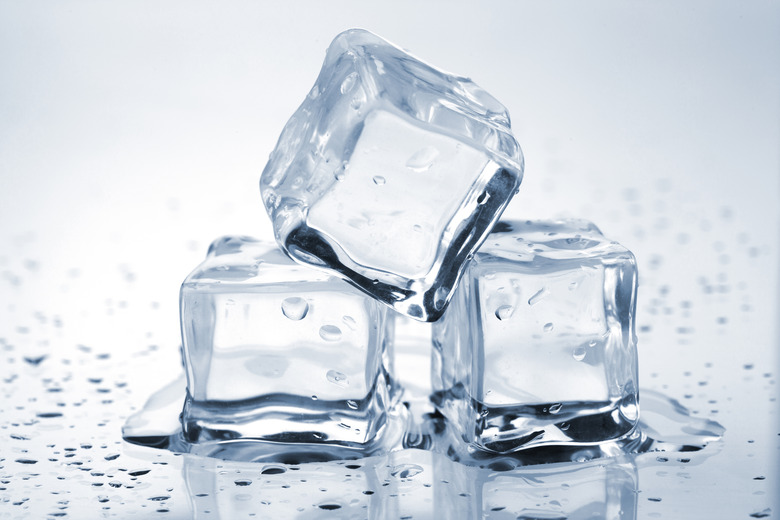How To Measure Heat Of Fusion Of Ice
"Heat" represents the thermal energy of molecules in a substance. Water freezes at 0 degrees Celsius. But the temperature of an ice cube can fall well below that. When an ice cube is removed from a freezer, the cube's temperature increases as it absorbs heat from its surroundings. But once the ice cube reaches 0 C, it begins to melt and its temperature stays at 0 throughout the melting process, even though the ice cube continues to absorb heat. This occurs because the thermal energy absorbed by the ice cube is consumed by water molecules separating from each other during melting.
The amount of heat absorbed by a solid during its melting phase is known as the latent heat of fusion and is measured via calorimetry.
Data Collection
Step 1
Place an empty Styrofoam cup on a balance and record the mass of the empty cup in grams. Then fill the cup with about 100 milliliters, or about 3.5 ounces, of distilled water. Return the filled cup to the balance and record the weight of the cup and water together.
Step 2
Place a thermometer into the water in the cup, wait about 5 minutes for the thermometer to come to thermal equilibrium with the water, then record the temperature of the water as the initial temperature.
Step 3
Place two or three ice cubes on a paper towel to remove any liquid water on the surfaces of the cubes, then quickly transfer the cubes to the Styrofoam cup. Use the thermometer to gently stir the mixture. Observe the temperature reading on the thermometer. It should begin to drop almost immediately. Continue stirring and record the lowest temperature indicated on the thermometer before the temperature begins to rise. Record this value as the "final temperature."
Step 4
Remove the thermometer and return the Styrofoam cup once again to the balance and record the mass of the cup, water and melted ice together.
Calculations
Step 1
Determine the mass of water in the cup by subtracting the mass of the empty cup from the weight of the cup and water together, as collected in step 1. For example, if the empty cup weighed 3.1 grams and the cup and water together weighed 106.5 grams, then the mass of the water was 106.5 – 3.1 = 103.4 g.
Step 2
Calculate the temperature change of the water by subtracting the initial water temperature from the final water temperature. Thus, if the initial temperature was 24.5 C and the final temperature was 19.2 C, then deltaT = 19.2 – 24.5 = -5.3 C.
Step 3
Calculate the heat, q, removed from the water according to the equation q = mc(deltaT), where m and deltaT represent the mass and temperature change of the water, respectively, and c represents water's specific heat capacity, or 4.184 joules per gram per degree Celsius, or 4.187 J/g-C. Continuing the example from steps 1 and 2, q = ms(deltaT) = 103.4 g * 4.184 J/g-C * -5.3 C = -2293 J. This represents the heat removed from the water, hence its negative sign. By the laws of thermodynamics, this means that the ice cubes in the water absorbed +2293 J of heat.
Step 4
Determine the mass of the ice cubes by subtracting the mass of the cup and water from the mass of the cup, water and ice cubes together. If the cup, water and ice together weighed 110.4 g, then the mass of the ice cubes was 110.4 g – 103.4 g = 7.0 g.
Step 5
Find the latent heat of fusion, Lf, according to Lf = q ÷ m by dividing the heat, q, absorbed by the ice, as determined in step 3, by the mass of ice, m, determined in step 4. In this case, Lf = q / m = 2293 J ÷ 7.0 g = 328 J/g. Compare your experimental result to the accepted value of 333.5 J/g.
Things Needed
- Styrofoam cup
- Balance capable of measuring to 0.1 grams
- Measuring cup
- Distilled water
- Thermometer
- Ice cubes
- Paper towel
- Calculator
TL;DR (Too Long; Didn't Read)
If you need the latent heat of fusion in units other than joules per gram, such as calories per gram, use an online unit conversion tool, such as the one provided in the Resources section.
Cite This Article
MLA
Brubaker, Jack. "How To Measure Heat Of Fusion Of Ice" sciencing.com, https://www.sciencing.com/measure-heat-fusion-ice-8097648/. 25 April 2018.
APA
Brubaker, Jack. (2018, April 25). How To Measure Heat Of Fusion Of Ice. sciencing.com. Retrieved from https://www.sciencing.com/measure-heat-fusion-ice-8097648/
Chicago
Brubaker, Jack. How To Measure Heat Of Fusion Of Ice last modified March 24, 2022. https://www.sciencing.com/measure-heat-fusion-ice-8097648/
